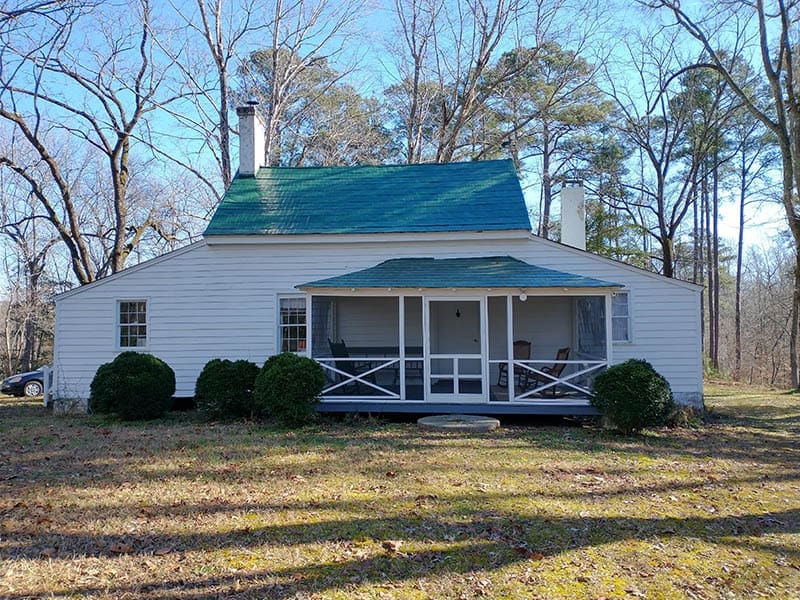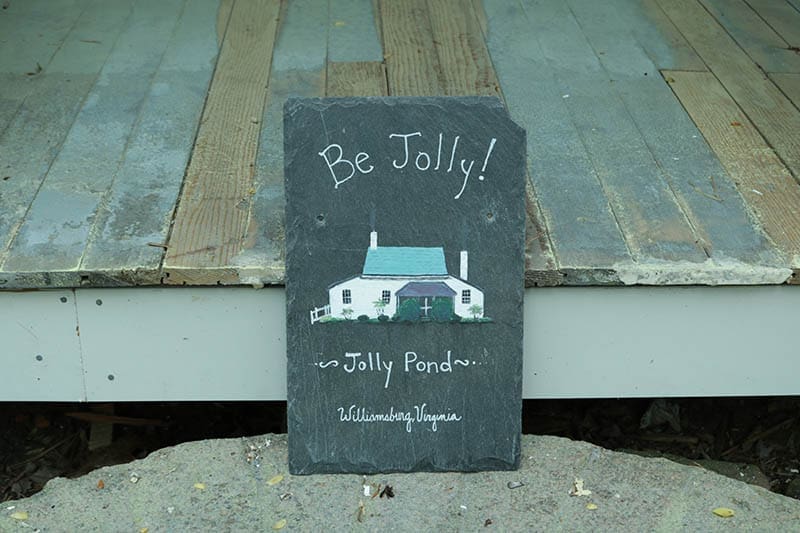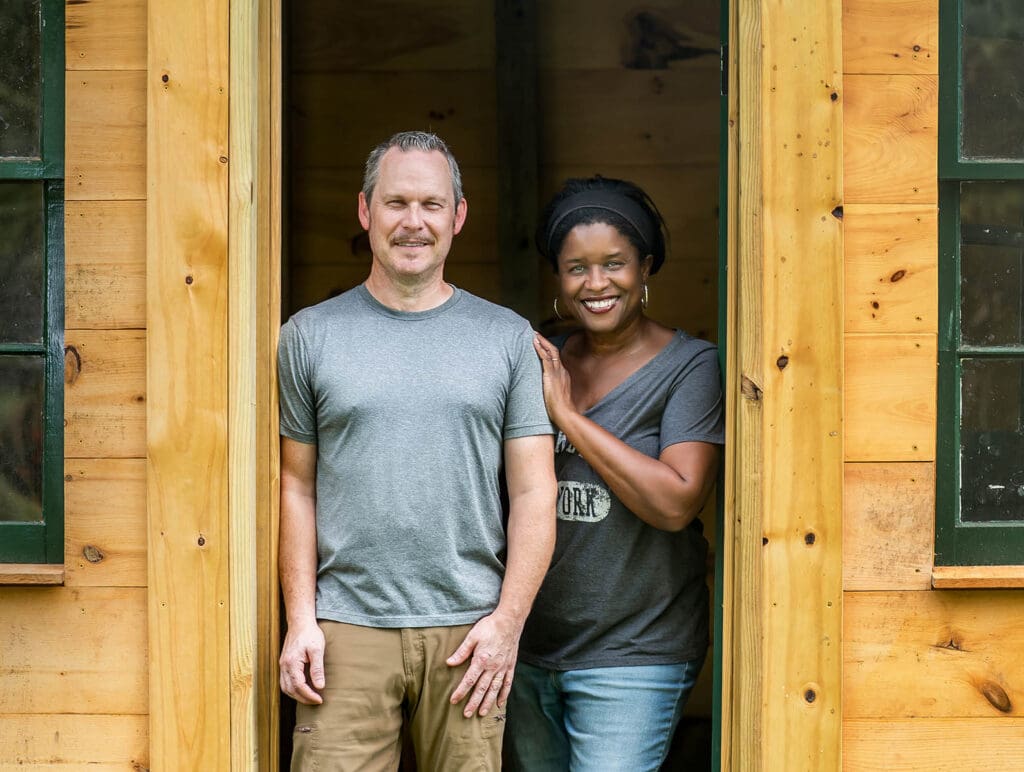A couple’s journey to unearth the fascinating history and heritage of their landmark Williamsburg property includes sharing its cultural and culinary treasures
By Ava Baker
Leading the way in mud-caked sneakers through a humid summer drizzle, Jolly’s Mill Pond co-owner Angi Kane pauses to direct the tour’s attention through the mist to a yawning cavity in the side of a hill.
What may look to the untrained eye like a natural case of erosion, is the spot where a couple centuries ago, enslaved laborers excavated tons of borrow fill for the property’s earthen dam. Just down the path, Kane pauses again, this time to point out a view of the pond that makes a four-second appearance in the music video for “The Valley Road” by Virginia’s own Bruce Hornsby & The Range, currently sitting at 10 million views on YouTube.
Two wildly juxtaposed historical landmarks, mere feet away from one another, paint a picture of just how many lives Jolly’s Mill Pond has lived. A Colonial-era grist mill, turned exclusive fishing hole, turned rustic family retreat, today the property acts as an event space, small scale farm, historical site and culinary heritage haven. The Pond is owned and operated by creative husband-and-wife duo Angi and Bill Kane.
The couple, having relocated to Virginia from Brooklyn over a decade ago, is now attempting to stoke the Williamsburg acreage to its full potential, with conservation of the land’s storied historical identity being the highest priority.
Though the property has been in Bill’s family since the early 1950s, when his great aunt and trailblazing head of Virginia Game & Inland Fisheries purchased the land, much of its history is only now being unearthed. The pond was formed sometime in the late 1700s, with Preservation Virginia dating the dam’s construction to 1782.
The dam was built to power a grist mill, one of thousands in the state. This one was commissioned by John Coke, namesake of the Coke-Garrett House, now home to the president of the Colonial Williamsburg Foundation. For the next hundred years, the mill carried out operations until it was torn down in the early 1900s.


This knowledge presented one of the property’s first mysteries for the Kanes: Where was the mill located? While both Bill and Angi’s careers have found them playing many roles in creative, educational, and scientific fields–Angi even being an Emmy-winning documentarian–The Pond now had them playing detective.
Luckily, Bill’s knowledge of geology combined with his experience running around the surrounding woods as a kid, helped him distinguish the land’s quirks. Eventually, he was able to identify manmade berms and traces of the old millrace carved into the earth, ultimately allowing him to determine its original footprint with near certainty. As they continued fleshing out the land’s timeline, items left behind in the main house were adding pieces to the puzzle.
“Part of the story,” Angi explains, “has been managing the massive amount of stuff. We have a graphics library. Stuff that’s been shoved in corners in the garage—old catalogues, books, magazines.” The couple came across ledgers denoting the formation of a private fishing club in 1915, and member stock certificates showing the club’s $1,000 fee, a hefty sum for the early 20th century.

An exciting twist in the story for Angi came when she learned that she was not the first Black owner of The Pond. One name, Jeremiah Wallace, kept appearing in their research. Answers came when, after Angi posted a triptych to The Pond’s website asking for any information people had on Wallace, she was contacted by his great granddaughter. A Hampton University graduate, farmer and real estate developer, Wallace owned the land for about a year in the early 1900s, and many of his descendants still live in the area.
Community outreach has yielded other historically significant results—many of which are agriculture based, Angi’s personal favorite part of the Jolly’s Mill story. She reached out to a culinary historian to narrow down what grains would have been used on the property and what heritage ingredients would be relevant to the area. Excited about what she found and eager to bring others along for the ride, she began offering seasonal culinary heritage experiences, both in person at The Pond and virtually.
Some examples of classes on the roster include The History of Barbecue, Bacon and Johnny Cakes, and to heat things up, Open Fire Cooking for Beginners. Rooted in Black and Indigenous food traditions of the South, dishes are prepared on an open hearth using the property’s heirloom ingredients, each with its own backstory, which anyone can dive into via the Jolly’s Mill Pond blog. From sumac to the fish pepper, each ingredient is explored to its fullest potential and given its time to shine.
That’s a recurring theme in the project’s ethos. Through the Kanes’ diligence in uncovering these stories, it’s clear how sensitive the two are to the character of the property and all it has to offer. Both creatives to the core, Jolly’s Mill Pond has become their muse. The main house itself looks as if you’re stepping back in time. Antiques have been thoughtfully sourced, and repairs are made with character in mind. The failing horsehair wall was patched up entirely by hand in lieu of a much quicker dry wall solution. They even mixed the plaster with water from the property’s well.
Angi says the couple often gets asked, “Why is it that Bill and I are taking on this challenge? We’re doing it because of the history. We’re doing it because of conservation. We’re doing it because of legacy. And to become a model for other small landowners who don’t want to sell to developers.”
Described by local tourism sights as a hidden gem, Jolly’s Mill Pond is a microcosm of the brightly colored world of secret histories in and around America’s birthplace, ready to be uncovered by those willing to look.
Learn more at jollysmillpond.com.





























